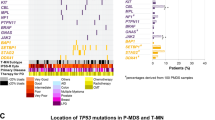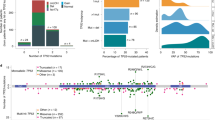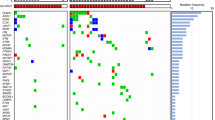Abstract
Therapy-related acute myeloid leukaemia (t-AML) and therapy-related myelodysplastic syndrome (t-MDS) are well-recognized complications of cytotoxic chemotherapy and/or radiotherapy1. There are several features that distinguish t-AML from de novo AML, including a higher incidence of TP53 mutations2,3, abnormalities of chromosomes 5 or 7, complex cytogenetics and a reduced response to chemotherapy4. However, it is not clear how prior exposure to cytotoxic therapy influences leukaemogenesis. In particular, the mechanism by which TP53 mutations are selectively enriched in t-AML/t-MDS is unknown. Here, by sequencing the genomes of 22 patients with t-AML, we show that the total number of somatic single-nucleotide variants and the percentage of chemotherapy-related transversions are similar in t-AML and de novo AML, indicating that previous chemotherapy does not induce genome-wide DNA damage. We identified four cases of t-AML/t-MDS in which the exact TP53 mutation found at diagnosis was also present at low frequencies (0.003–0.7%) in mobilized blood leukocytes or bone marrow 3–6 years before the development of t-AML/t-MDS, including two cases in which the relevant TP53 mutation was detected before any chemotherapy. Moreover, functional TP53 mutations were identified in small populations of peripheral blood cells of healthy chemotherapy-naive elderly individuals. Finally, in mouse bone marrow chimaeras containing both wild-type and Tp53+/− haematopoietic stem/progenitor cells (HSPCs), the Tp53+/− HSPCs preferentially expanded after exposure to chemotherapy. These data suggest that cytotoxic therapy does not directly induce TP53 mutations. Rather, they support a model in which rare HSPCs carrying age-related TP53 mutations are resistant to chemotherapy and expand preferentially after treatment. The early acquisition of TP53 mutations in the founding HSPC clone probably contributes to the frequent cytogenetic abnormalities and poor responses to chemotherapy that are typical of patients with t-AML/t-MDS.
This is a preview of subscription content, access via your institution
Access options
Subscribe to this journal
Receive 51 print issues and online access
$199.00 per year
only $3.90 per issue
Buy this article
- Purchase on Springer Link
- Instant access to full article PDF
Prices may be subject to local taxes which are calculated during checkout




Similar content being viewed by others
Accession codes
Data deposits
Sequence information on the 22 t-AML whole-genome sequencing patients and one exome sequencing patient (UPN 967645) has been deposited in dbGaP under accession number phs000159.
References
Godley, L. A. & Larson, R. A. Therapy-related myeloid leukemia. Semin. Oncol. 35, 418–429 (2008)
Christiansen, D. H., Andersen, M. K. & Pedersen-Bjergaard, J. Mutations with loss of heterozygosity of p53 are common in therapy-related myelodysplasia and acute myeloid leukemia after exposure to alkylating agents and significantly associated with deletion or loss of 5q, a complex karyotype, and a poor prognosis. J. Clin. Oncol. 19, 1405–1413 (2001)
Shih, A. H. et al. Mutational analysis of therapy-related myelodysplastic syndromes and acute myelogenous leukemia. Haematologica 98, 908–912 (2013)
Kayser, S. et al. The impact of therapy-related acute myeloid leukemia (AML) on outcome in 2853 adult patients with newly diagnosed AML. Blood 117, 2137–2145 (2011)
Link, D. C. et al. Identification of a novel TP53 cancer susceptibility mutation through whole-genome sequencing of a patient with therapy-related AML. J. Am. Med. Assoc. 305, 1568–1576 (2011)
The Cancer Genome Atlas Research Network Genomic and epigenomic landscapes of adult de novo acute myeloid leukemia. N. Engl. J. Med. 368, 2059–2074 (2013)
Walter, M. J. et al. Clonal architecture of secondary acute myeloid leukemia. N. Engl. J. Med. 366, 1090–1098 (2012)
Walter, M. J. et al. Clonal diversity of recurrently mutated genes in myelodysplastic syndromes. Leukemia 27, 1275–1282 (2013)
Ding, L. et al. Clonal evolution in relapsed acute myeloid leukaemia revealed by whole-genome sequencing. Nature 481, 506–510 (2012)
Petitjean, A. et al. Impact of mutant p53 functional properties on TP53 mutation patterns and tumor phenotype: lessons from recent developments in the IARC TP53 database. Hum. Mutat. 28, 622–629 (2007)
Welch, J. S. et al. The origin and evolution of mutations in acute myeloid leukemia. Cell 150, 264–278 (2012)
Catlin, S. N., Busque, L., Gale, R. E., Guttorp, P. & Abkowitz, J. L. The replication rate of human hematopoietic stem cells in vivo. Blood 117, 4460–4466 (2011)
Carvajal, L. A. & Manfredi, J. J. Another fork in the road—life or death decisions by the tumour suppressor p53. EMBO Rep. 14, 414–421 (2013)
Chen, X., Ko, L. J., Jayaraman, L. & Prives, C. p53 levels, functional domains, and DNA damage determine the extent of the apoptotic response of tumor cells. Genes Dev. 10, 2438–2451 (1996)
Purvis, J. E. et al. p53 dynamics control cell fate. Science 336, 1440–1444 (2012)
Zhang, X. P., Liu, F., Cheng, Z. & Wang, W. Cell fate decision mediated by p53 pulses. Proc. Natl Acad. Sci. USA 106, 12245–12250 (2009)
Zhang, X. P., Liu, F. & Wang, W. Two-phase dynamics of p53 in the DNA damage response. Proc. Natl Acad. Sci. USA 108, 8990–8995 (2011)
Hollstein, M., Sidransky, D., Vogelstein, B. & Harris, C. C. p53 mutations in human cancers. Science 253, 49–53 (1991)
Kandoth, C. et al. Mutational landscape and significance across 12 major cancer types. Nature 502, 333–339 (2013)
Bondar, T. & Medzhitov, R. p53-mediated hematopoietic stem and progenitor cell competition. Cell Stem Cell 6, 309–322 (2010)
Marusyk, A., Porter, C. C., Zaberezhnyy, V. & DeGregori, J. Irradiation selects for p53-deficient hematopoietic progenitors. PLoS Biol. 8, e1000324 (2010)
Greaves, M. & Maley, C. C. Clonal evolution in cancer. Nature 481, 306–313 (2012)
Birch, J. M. et al. Relative frequency and morphology of cancers in carriers of germline TP53 mutations. Oncogene 20, 4621–4628 (2001)
Casás-Selves, M. & Degregori, J. How cancer shapes evolution, and how evolution shapes cancer. Evolution 4, 624–634 (2011)
Mardis, E. R. et al. Recurring mutations found by sequencing an acute myeloid leukemia genome. N. Engl. J. Med. 361, 1058–1066 (2009)
Li, H. & Durbin, R. Fast and accurate short read alignment with Burrows–Wheeler transform. Bioinformatics 25, 1754–1760 (2009)
Li, H. et al. The Sequence Alignment/Map format and SAMtools. Bioinformatics 25, 2078–2079 (2009)
Larson, D. E. et al. SomaticSniper: identification of somatic point mutations in whole genome sequencing data. Bioinformatics 28, 311–317 (2012)
McKenna, A. et al. The Genome Analysis Toolkit: a MapReduce framework for analyzing next-generation DNA sequencing data. Genome Res. 20, 1297–1303 (2010)
Ye, K., Schulz, M. H., Long, Q., Apweiler, R. & Ning, Z. Pindel: a pattern growth approach to detect break points of large deletions and medium sized insertions from paired-end short reads. Bioinformatics 25, 2865–2871 (2009)
Chen, K. et al. BreakDancer: an algorithm for high-resolution mapping of genomic structural variation. Nature Methods 6, 677–681 (2009)
Koboldt, D. C. et al. VarScan 2: somatic mutation and copy number alteration discovery in cancer by exome sequencing. Genome Res. 22, 568–576 (2012)
Kinde, I., Wu, J., Papadopoulos, N., Kinzler, K. W. & Vogelstein, B. Detection and quantification of rare mutations with massively parallel sequencing. Proc. Natl Acad. Sci. USA 108, 9530–9535 (2011)
Schmitt, M. W. et al. Detection of ultra-rare mutations by next-generation sequencing. Proc. Natl Acad. Sci. USA 109, 14508–14513 (2012)
Langmead, B. & Salzberg, S. L. Fast gapped-read alignment with Bowtie 2. Nature Methods 9, 357–359 (2012)
Thorvaldsdóttir, H., Robinson, J. T. & Mesirov, J. P. Integrative Genomics Viewer (IGV): high-performance genomics data visualization and exploration. Brief. Bioinform. 14, 178–192 (2013)
Wickham, H. ggplot2: Elegant Graphics for Data Analysis (Springer, 2009)
Bustin, S. A. et al. The MIQE guidelines: minimum information for publication of quantitative real-time PCR experiments. Clin. Chem. 55, 611–622 (2009)
Hindson, B. J. et al. High-throughput droplet digital PCR system for absolute quantitation of DNA copy number. Anal. Chem. 83, 8604–8610 (2011)
Acknowledgements
We thank A. Schmidt, B. McKethan and R. Miller for technical assistance, and K. Odell and J. Tucker-Davis for animal care. We thank P. Goodfellow and J. Ivanovich for providing peripheral blood leukocyte genomic DNA from cancer-free individuals. This work was supported by National Institutes of Health grants PO1 CA101937 (D.C.L.) and U54 HG003079 (R.K.W.) and by a grant from the Leukemia & Lymphoma Society (D.C.L.).
Author information
Authors and Affiliations
Contributions
T.N.W. and G.R. designed and performed the research, analysed the data, and wrote the manuscript. A.L.Y. and T.E.D. developed and optimized the amplicon-based random primer sequencing assay. C.A.M., D.S., J.H., R.S.F., L.D., E.R.M. and R.K.W. contributed to the generation and analysis of the whole-genome or targeted sequencing. W.T., T.L.L., S.H., J.M.K. and P.W. collected and processed clinical data and tissue samples. J.D.B. performed statistical analyses of the clinical data. J.S.W., J.F.D., M.J.W., T.A.G. and T.J.L. contributed to data analysis. D.C.L. supervised all of the research and edited the manuscript, which was approved by all co-authors.
Corresponding author
Ethics declarations
Competing interests
The authors declare no competing financial interests.
Extended data figures and tables
Extended Data Figure 1 Whole-genome sequencing analysis of t-AML.
a, Somatic copy number alterations in the 22 cases of t-AML. Blue indicates copy number loss; red indicates copy number gain. b, Representative clonality plots for 8 cases of t-AML are shown. Scatter plots (bottom) show variant allele frequency and read depth in the tumour sample. Variant alleles in the founding clone are depicted in green, while variants in subclones are depicted in orange or purple. Top, kernel density plots of the VAF data (green line) along with the posterior predictive densities (grey line) from the mathematical model used to segregate clusters. c, Frequency of tier 1 silent, tier 2, and tier 3 mutations in 1 Mb increments across chromosome 17 in de novo AML and t-AML. The TP53 genomic locus is identified.
Extended Data Figure 2 TP53 mutations are associated with decreased overall survival in t-AML/t-MDS.
a, Overall survival in TP53 mutated (n = 13) and TP53 wild-type (n = 39) t-AML patients. b, Overall survival in TP53 mutated (n = 24) and TP53 wild-type (n = 35) t-MDS patients.
Extended Data Figure 3 Model of how cytotoxic therapy shapes clonal evolution in t-AML/t-MDS.
Age-related mutations in HSPCs result in the production of a genetically heterogeneous population of HSPCs, including rare HSPCs with heterozygous TP53 mutations in some individuals. During chemotherapy and/or radiotherapy for the primary cancer, HSPC clones harbouring a TP53 mutation have a competitive advantage, resulting in expansion of that clone. Subsequent acquisition of additional driver mutations results in transformation to t-AML/t-MDS. Of note, the presence of TP53 mutations probably accounts for the high incidence of cytogenetic abnormalities in t-AML/t-MDS and poor response to chemotherapy.
Extended Data Figure 4 Validation of the unique adaptor sequencing method.
a, Unique adaptor sequencing approach. Step 1: genomic DNA is amplified with TP53-specific primers (green) with subpopulation-specific variant alleles highlighted in red. Step 2: randomly indexed adapters (tan and grey) are ligated to each amplicon. Step 3: the indexed amplicons are amplified to generate multiple reads possessing the same barcode (that is, read families). Step 4: after sequencing, reads are aligned and grouped by read families to generate an error-corrected consensus sequence. Sequencing errors (yellow) are randomly distributed amongst read families, while true variant alleles (red) are present in all members of a given read family. b, A tumour sample (UPN 895681) with a known TP53 somatic mutation (chromosome 17: 7519119 T to A) at a VAF of ∼37% was mixed with normal genomic DNA sample at the indicated ratio, and conventional (left) or unique adaptor next-generation sequencing (middle and right) was performed, as described in Methods. DNA degradation with time may result in errors that are then amplified during PCR, providing a source of false-positive calls. This is particularly true for C to A transversions. Since none of the TP53 mutations analysed in this study were C to A transversions, we also analysed the data after removing C to A calls (right). The TP53 variant allele is circled in blue. c, The threshold of detection for the variant allele with each sequencing method is shown.
Extended Data Figure 5 Clonal evolution in case 314666.
a, Clinical course of case 341666. Chemo, chemotherapy; DLBCL, diffuse large B-cell lymphoma; XRT, radiotherapy. b, Unique adaptor sequencing was performed on genomic DNA derived from leukapharesis samples obtained 3 years before the diagnosis of t-MDS for the two clonal mutations present in the diagnostic t-MDS sample. Genomic DNA from a patient lacking these variants was used as a control. The blue circle indicates the position of the variant SNV. c, Proposed model of clonal evolution to t-MDS in this case.
Extended Data Figure 6 ddPCR verification of selected somatic TP53 mutations identified in peripheral blood of cancer-free individuals.
a–c, ddPCR was performed on genomic DNA isolated from the peripheral blood of cancer-free individuals (middle) for whom unique-read adaptor sequencing suggested the presence of the indicated TP53 mutation. Controls represent peripheral blood DNA from cancer-free elderly individuals with VAFs not above background levels for the mutation of interest (right); the negative control for TP53 Y220C is shown in Fig. 3b. a, The diagnostic t-AML sample from patient 967645 was used as a positive control for TP53 Y220C. b, c, For TP53 V173M (b) and TP53 I195T (c) double-stranded genomic blocks (gBlocks) were synthesized containing the mutation of interest and mixed with gBlocks of wild-type sequence. Droplets containing only the variant TP53 allele are highlighted in orange, droplets containing the wild-type TP53 allele (with or without the variant TP53 allele) are highlighted in blue; empty droplets are grey. The number of droplets in each gate is indicated.
Supplementary information
Supplementary Information
This file contains Supplementary notes. (PDF 149 kb)
Supplementary Data
This zipped file contains Supplementary Tables 1-11. (ZIP 1228 kb)
Rights and permissions
About this article
Cite this article
Wong, T., Ramsingh, G., Young, A. et al. Role of TP53 mutations in the origin and evolution of therapy-related acute myeloid leukaemia. Nature 518, 552–555 (2015). https://doi.org/10.1038/nature13968
Received:
Accepted:
Published:
Issue Date:
DOI: https://doi.org/10.1038/nature13968
This article is cited by
-
Pharmacological reactivation of p53 in the era of precision anticancer medicine
Nature Reviews Clinical Oncology (2024)
-
5G2 mutant mice model loss of a commonly deleted segment of chromosome 7q22 in myeloid malignancies
Leukemia (2024)
-
Analysis of clinical and genomic profiles of therapy-related myeloid neoplasm in Korea
Human Genomics (2023)
-
Convergent TP53 loss and evolvability in cancer
BMC Ecology and Evolution (2023)
-
Accurate interpretation of p53 immunohistochemical patterns is a surrogate biomarker for TP53 alterations in large B-cell lymphoma
BMC Cancer (2023)
Comments
By submitting a comment you agree to abide by our Terms and Community Guidelines. If you find something abusive or that does not comply with our terms or guidelines please flag it as inappropriate.



